|
Family: Apodidae (swifts, spinetails)
Life > Eukaryotes > Opisthokonta > Metazoa (animals) > Bilateria > Deuterostomia > Chordata > Craniata > Vertebrata (vertebrates) > Gnathostomata (jawed vertebrates) > Teleostomi (teleost fish) > Osteichthyes (bony fish) > Class: Sarcopterygii (lobe-finned fish) > Stegocephalia (terrestrial vertebrates) > Tetrapoda (four-legged vertebrates) > Reptiliomorpha > Amniota > Reptilia (reptiles) > Romeriida > Diapsida > Archosauromorpha > Archosauria > Dinosauria (dinosaurs) > Saurischia > Theropoda (bipedal predatory dinosaurs) > Coelurosauria > Maniraptora > Aves (birds) > Order: Apodiformes
There are 99 species of which 13 occur in southern
Africa.
Species indigenous to southern Africa
|
Apus
affinis (Little swift) The Little swift occurs almost everywhere in sub-Saharan
Africa, and is often found near built up areas or cliffs, as it uses them as
nest sites. It eats exclusively arthropods, such as termite alates, dragonflies, grasshoppers, Spiders and mantids,
often hunting them at high altitudes. It is a colonial nester, with colonies
of up to 30 nests placed close together. Both sexes build the nest, which is
a untidy closed bowl, made of grass and feathers glued together with saliva.
It lays 1-3 eggs, which are incubated by both sexes, for 20-26 days. The
chicks stay in the nest for 36-40 days, after which they become fully
independent. |
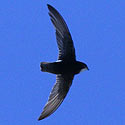 |
|
Apus apus
(Common swift, European swift) The Common swift
breeds from China through Asia to Europe and and North Africa, with
non-breeding grounds encompassing the whole of sub-Saharan Africa. It is a
palearctic non-breeding migrant, usually arriving in southern Africa in
October-November, leaving roughly from January-March. It exclusively eats
arthropods, foraging at much higher altitudes than local-breeding swifts,
often reaching heights of 1500-3000 m above ground, usually flying at 36-90
km/hr, but it has been known to reach 216 km/hr in certain conditions!
Interestingly, it is permanently airborne in non-breeding grounds, roosting
on the wing. |
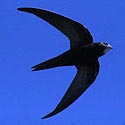 |
|
Apus
barbatus (African black swift, Black swift)
The African black swift occurs in large areas of sub-Saharan Africa, with
the bulk of its population in eastern as well as southern Africa. It feeds
primarily on flying insects, often hunting in mixed species flocks,
especially during termite alate emergences. It can cover around 1000 km's in
one day's hunting, after which it usually roosts in rock crevices or tree
cavities. Its breeding habits are little known, however it is thought to be
a monogamous, colonial nester, building a nest made of feathers and grass,
glued together with its saliva. It is usually placed in rock crevices or
caves, often in cliff faces. |
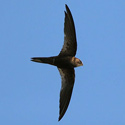 |
|
Apus
bradfieldi (Bradfield's swift) Near endemic
to southern Africa, occurring from south-western Angola to Namibia and the
Northern Cape. It generally prefers arid habitats, such as desert and open
savanna, often rocky, mountainous areas. It forages in flocks, almost
exclusively eating termite alates, bees and other flying insects. Its
breeding habits are little known, however it is thought to be a monogamous
colonial nester. The nest is a makeshift half cup, made of plant material
and feathers glued together with saliva. They are usually grouped in
colonies, often in rock crevices, buildings, mine workings and dead fronds
of alien palm trees. |
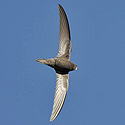 |
|
Apus
caffer (White-rumped swift) The White-rumped
swift is widespread and common, occurring across sub-Saharan Africa. It
often forages in mixed species flocks, usually over savanna, forest,
grassland or shrubland, eating mainly termite alates. It usually steals the
nests of other swifts and swallows, aggressively chasing the breeding pair
away, before evicting any chicks or eggs present in the nest. The female
actually lays multiple clutches of 1-5 eggs in one breeding season, waiting
only a week after the chicks have fledged before laying another clutch. This
process, known as multi-brooding, is part of the reason that this species is
so common, as it means that one female can produce dozens of chicks
annually. |
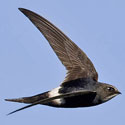 |
|
Apus horus
(Horus swift) The bulk of the Horus swift's
population is in southern Africa, mainly in South Africa and Zimbabwe but
strangely absent from Botswana. It usually forages in flocks over open
areas, feeding on a wide range of insects. It is a monogamous, colonial
nester, often living in mixed-species colonies of about 2-10 breeding pairs.
It usually takes control of old tunnels excavated by other birds, building a
small pad out of diverse materials glued together with saliva, which it
places in the chamber at the tunnel's end. Here it lays 2-4 eggs, which are
incubated for about 28 days. The chicks are born with a grey-coloured down,
and are cared for by both parents. |
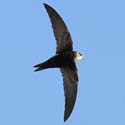 |
|
Apus
pallidus (Pallid swift) |
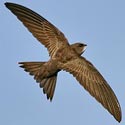 |
|
Cypsiurus
parvus (African palm-swift, Palm swift) The
African palm-swift originated in the lowland forests of Equatorial Africa,
but now it occurs across sub-Saharan Africa, preferring savanna or urban
areas with scattered palm trees. In the last 60-70 years its range has
expanded exponentially, due to human exploits and the planting of palm
trees. It usually lives in colonies of up to 100 active nests, which each
consist of a shallow cup, mostly made of feathers glued together with
saliva, normally placed on the upper side of palm fronds. Here it lays 1-2
eggs, which the female immediately glues to the nest, using her own saliva.
The eggs are then incubated by both sexes, for 18-22 days. The chicks are
brooded and fed by both sexes, leaving the nest when they are about 29-33
days old, at which point they become fully independent. |
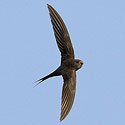 |
|
Neafrapus
boehmi (Böhm's spinetail) |
|
|
Schoutedenapus
myoptilus (Scarce swift) |
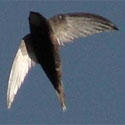 |
|
Tachymarptis
aequatorialis (Mottled swift) |
|
|
Tachymarptis
melba (Alpine swift) The Alpine swift is
patchily distributed across sub-Saharan Africa, and is most common in
southern Africa, especially in Namibia and South Africa. It forages in mixed
species flocks, along with other swifts and swallows, and can travel up to
about 1000 km's in a day! It tends to fly at extremely high altitudes,
however it does occasionally come down to the ground to feed on
grasshoppers, honey bees, etc. It is a colonial nester, living in colonies
of about 20-35 breeding pairs, who construct bowl-shaped nests, usually
placed so that they bridge a vertical rock crack, with multiple nests often
stacked on top of each other, like apartment blocks. Nests tend to be reused
over multiple breeding seasons, in fact a 28 year old colony has been
recorded in the Western Cape. |
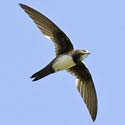 |
|
Telacanthura
ussheri (Mottled spinetail) The Mottled spinetail
is patchily distributed across sub-Saharan Africa, and is most common along
the West African coast. In southern Africa it is scarce and localised, with
scattered populations in Zimbabwe, Mozambique and the Caprivi Strip. It
mainly forages in small flocks, usually over dense woodland, such as miombo (Brachystegia) woodland, evergreen and riverine forest, etc.
It usually lives in colonies of about 2-5 breeding pairs, however it does
occasionally nest solitarily. The nest is a half saucer, built of a wide
variety of materials glued together with saliva. It is almost always placed
in a cavity in a Baobab tree, however in other parts of Africa it also nests
in buildings and crevices. |
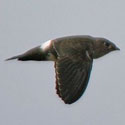 |
|
